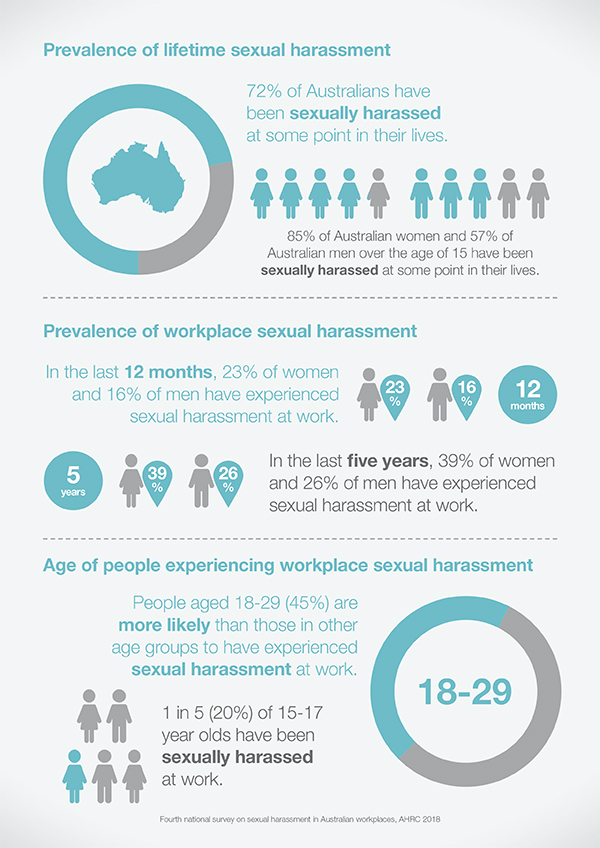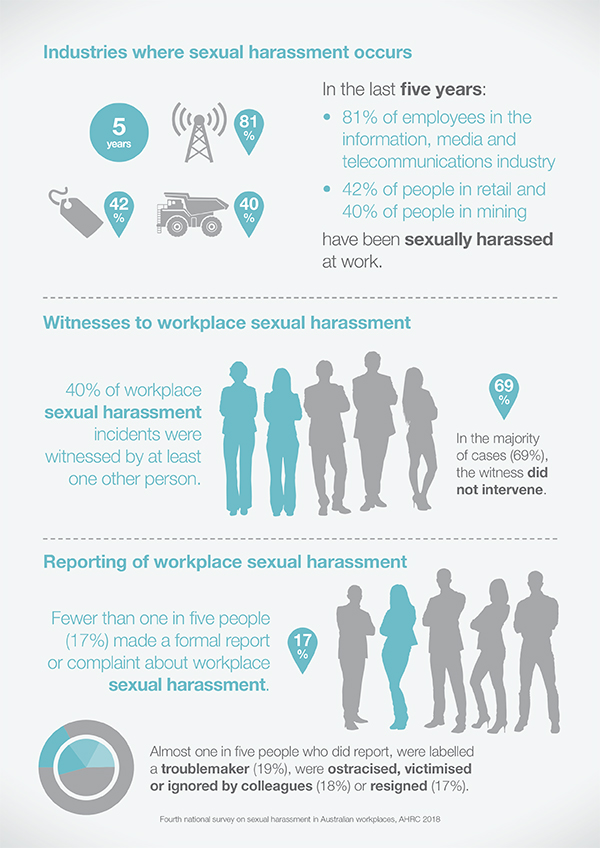Everyone’s business: Fourth national survey on sexual harassment
Archived
You are in an archived section of the website. This information may not be current.
This page was first created in September, 2018

Everyone’s business: Fourth national survey on sexual harassment in Australian workplaces (2018)
Commissioner’s foreword
I am pleased to present this report on the fourth National workplace sexual harassment survey, which outlines the findings of the Australian Human Rights Commission’s latest survey on the prevalence, nature and reporting of sexual harassment in Australia, with a focus on workplaces. This is the fourth such survey undertaken by the Commission since 2003.
Funding for this year’s National Survey was provided by the Australian Government Department of Social Services under the National Plan to Reduce Violence against Women and their Children 2010–2022. I would like to thank the Department for its support of this important work.
The results of the 2018 National Survey are more detailed and more robust than ever before, with more than 10,000 Australians surveyed—five times the number of people who have participated in previous years.
This is a notable year for the 2018 National Survey for other reasons as well. The results of the survey are perhaps more timely and relevant in 2018 than ever before, with the huge surge in public concern about sexual harassment generated by the #MeToo movement around the world, including in Australia. The Australian public has rightly demanded to know more about the pervasiveness and impact of workplace sexual harassment and to see concerted action taken to prevent this behaviour from occurring. Government and employers need reliable data to inform their actions and responses to workplace sexual harassment.
The 2018 National Survey meets these demands by providing a rich collection of data on the sexual harassment experiences of Australians aged 15 to 65, using a sample that is representative of the Australian population in terms of gender, age and geographic location.
2018 is also a notable year for the National Survey because, earlier this year, I announced Australia’s first National Inquiry into sexual harassment in Australian workplaces. The survey findings will inform our work on the National Inquiry, by providing a base against which we can consider the extensive information that we will gather through our research and consultations.
We can learn a great deal from this year’s National Survey. It confirms that sexual harassment is widespread and pervasive. An extraordinary number, one in three people, have experienced sexual harassment at work in the last five years. This is a marked increase in the prevalence rate recorded by previous surveys. We cannot be certain if this is due to an increase in sexually harassing behaviours, or to greater awareness of the types of behaviours that constitute sexual harassment, or to other factors. What we are certain of is that this is a problem that affects millions of Australians and we, collectively, have a big job ahead to tackle the problem.
The data paints a comprehensive picture of the nature of sexual harassment in Australian workplaces. In the vast majority of cases, it is perpetrated by a man and in many cases; it is ongoing over an extended period. Half of victims have experienced similar harassment before, and a substantial proportion experience negative consequences as a result, such as impacts on mental health or stress. While sexual harassment is an issue across all industries, rates are particularly high in the information, media and telecommunications industry.
Disturbingly, the survey reveals that reporting of workplace sexual harassment continues to be low. Only 17% of people who experienced sexual harassment at work in the last five years made a formal report or complaint about the harassment. This finding highlights the importance of employers taking steps both to prevent workplace sexual harassment from occurring and to ensure that they respond appropriately when a report is made.
This years’ survey results also suggest that more work is needed to encourage and support the action of bystanders in the workplace—people who witness or hear about the sexual harassment of another person at their work. Although more than one in three people in 2018 were bystanders to the sexual harassment of someone else in their workplace (a threefold increase since 2012), only one-third of them took action in response. This is a drop compared to 2012, when half of bystanders took action. As bystanders can make a significant contribution to preventing workplace sexual harassment, these results highlight the need to target our efforts at supporting bystanders to take a stand against sexual harassment.
The 2018 National Survey provides the entire community—government, employers and the general public—with a robust evidence base to help understand the dimensions of sexual harassment in Australia, especially in our workplaces. However, more importantly, the survey findings compel us to take action to change the underlying social norms and inequalities that contribute to sexual harassment, to change workplace cultures that do little to address sexual harassment and to respond appropriately when sexual harassment occurs. Our goal must be to ensure all people work in an environment that is safe and non-threatening.
Kate Jenkins
Sex Discrimination Commissioner
August 2018
Infographics





